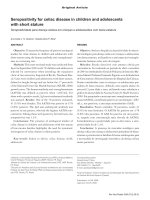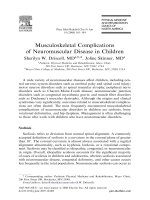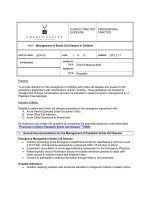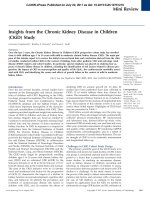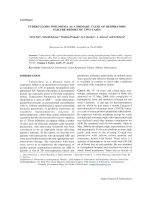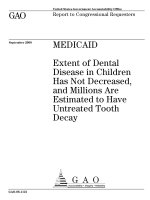Cushing’s Disease in Children: Report of Three Cases potx
Bạn đang xem bản rút gọn của tài liệu. Xem và tải ngay bản đầy đủ của tài liệu tại đây (285.29 KB, 5 trang )
©2010 Taiwan Pediatric Association
CASE REPORT
Pediatr Neonatol 2010;51(5):303−307
*Corresponding author. Department of Pediatrics, National Taiwan University Hospital, 7 Chung-Shan South Road, Taipei, Taiwan.
E-mail:
Cushing’s disease is rare in children and adolescents. We report the clinical presenta-
tions of three children with Cushing’s disease. All three exhibited the typical symptoms
and signs of weight gain and growth retardation. Two also demonstrated personality
changes, hypertension and hypokalemia, the last of these being rarely reported in
patients with Cushing’s disease. Lack of diurnal changes in serum cortisol levels was
the most common biochemical finding. Serum cortisol levels were suppressed by low-
dose dexamethasone in one patient, which is not typical for patients with Cushing’s
disease. Imaging studies are essential for localizing the tumor. Transsphenoidal surgery
remains the treatment of choice, and pituitary irradiation should be considered for
those patients whose tumors cannot be totally removed. Careful follow-up of these
patients with awareness of the possibilities of relapse and the complications of
hypopituitarism is indicated.
Cushing’s Disease in Children: Report of
Three Cases
Ping-Yi Hsu
1
, Yi-Ching Tung
2
, Cheng-Ting Lee
2
, Fu-Sung Lo
3
,
Mu-Zon Wu
4
, Wen-Yu Tsai
2
*, Yong-Kwang Tu
5
1
Department of Pediatrics, National Taiwan University Hospital, Yun-Lin Branch, Yun-Lin, Taiwan
2
Department of Pediatrics, National Taiwan University Hospital and College of Medicine,
National Taiwan University, Taipei, Taiwan
3
Department of Pediatrics, Chang Gung Memorial Hospital, Taoyuan, Taiwan
4
Department of Pathology, National Taiwan University Hospital and College of Medicine,
National Taiwan University, Taipei, Taiwan
5
Department of Surgery National Taiwan University Hospital and College of Medicine,
National Taiwan University, Taipei, Taiwan
Received: Nov 12, 2009
Revised: Apr 8, 2010
Accepted: May 1, 2010
KEY WORDS:
Cushing’s syndrome;
Cushing’s disease;
hypokalemia
1. Introduction
Cushing’s syndrome, or hypercortisolism, describes
the clinical manifestations of glucocorticoid excess
from any sources. Cushing’s disease specifically refers
to hypercortisolism due to excessive adrenocorti-
cotropic hormone (ACTH) secretion from a pituitary
adenoma.
1
It is rare in children and adolescents.
2,3
The early presentations of hypercortisolism in chil-
dren are weight gain and growth failure.
4−9
Other
common symptoms include moon face, plethora,
acne, hirsutism, striae, hypertension, puberty arrest,
and personality changes.
4−9
The last of these symp-
toms has been variably reported in children.
3−7
Confirmation and differential diagnosis of
Cushing’s disease is not an easy task, especially in
children. Hypercortisolism is usually manifested by
the lack of a normal circadian rhythm of cortisol
secretion. The localization of lesions usually relies
on imaging studies and the suppressibility of the
hypothalamic-pituitary-adrenal axis by dexametha-
sone.
2−6,9−14
The diagnosis and appropriate treatment
304 P.Y. Hsu et al
of these children may prevent future adult height
deficits and osteopenia.
9,15,16
Transsphenoidal pitui-
tary adenomectomy is the treatment of choice in
these children, and a high cure rate has been re-
ported.
3−6,8−10
Here, we report the clinical presen-
tations, diagnosis and treatment of three children
with Cushing’s disease, which may help clinicians to
make an early diagnosis in such patients.
2. Case Report
2.1. Case 1
This boy was diagnosed at the age of 12 years and
9 months, with a history of rapid weight gain for 10
months before admission. Insomnia, decreased appe-
tite, weight loss, depression, and regressive behavior
had also been noted for 6 months before admission.
He had been treated for depression with no improve-
ment in symptoms. An initial endocrine evaluation
revealed some acne on his face, but neither moon
face nor buffalo hump was noted. His growth rate
was 1.1 cm/year during this period. He had a height
of 148.6 cm (25−50
th
percentile), a weight of 34.3 kg
(10−25
th
percentile) and blood pressure of 160/
110 mmHg. He had signs of puberty; both testes
had volumes of 8 mL and pubic hair was at Tanner
stage I. His bone age was between 12 years 6 months
and 13 years.
Laboratory tests showed serum sodium of
146 mmol/L, potassium of 2.4 mmol/L, and chloride
of 101 mmol/L. His plasma ACTH level was 73.9 pg/
mL (16.3 pmol/L), and serum cortisol levels were
43.3 μg/dL (1195 nmol/L) at 8 AM and 26.6 μg/dL
(734 nmol/L) at 11 PM. His serum cortisol [> 50 μg/dL
(> 1329 nmol/L)] was not suppressed by a low-dose
dexamethasone suppression test (dexamethasone
20 μg/kg/day); however, a subsequent high-dose
dexamethasone suppression test (dexamethasone
80 μg/kg/day) suppressed the patient’s serum cor-
tisol level to 26.1 μg/dL (720 nmol/L). Magnetic res-
onance imaging (MRI) of the sella turcica disclosed
a 0.8-cm pituitary adenoma (Figure 1). The patient
underwent transsphenoidal pituitary adenomectomy,
and transient rhinorrhea of the cerebrospinal fluid
was noted. An ACTH-secreting pituitary adenoma
was confirmed by pathologic examination. The symp-
toms, including the psychological problems, improved
gradually after surgery.
Unfortunately, recurrence of Cushing’s syn-
drome was noted 1 year after surgery, with symptoms
of weight gain, moon face, and emotional instability.
Transcranial tumor excision was performed 11 months
later, and transient neurologic diabetes insipidus
was noted postoperatively. Because residual tumor
was detected after surgery, the patient underwent
Figure 1 Magnetic resonance image of case 1. Coronal
T1-weighted image with gadolinium enhancement showed
a 0.8-cm pituitary adenoma.
radiotherapy with a total dose of 5000 cGy. The signs
and symptoms improved, though panhypopituitarism
was noted 4 years after the second operation and
radiotherapy. The patient received continuing treat-
ment with eltroxin, cortisone acetate, and testos-
terone cypionate, with no evidence of recurrence
after 13 years’ follow-up.
2.2. Case 2
This girl presented at the age of 11 years and 3
months. She had experienced rapid weight gain from
31 kg to 65 kg, but had only grown by 7 cm in height in
2 years. Acne and facial flushing were also noted.
No previous medication had been prescribed. The
patient had initially ignored the symptoms, but fre-
quent poor appetite, nausea, vomiting, and abdomi-
nal pain developed 6 months prior to attendance at
our pediatric endocrine clinic. Moon face, buffalo
hump, generalized obesity, and purpuric striae were
noted. She had a height of 149.8 cm (75−90
th
percen-
tile), weight of 65 kg (above the 97
th
percentile), and
blood pressure of 114/80 mmHg. Her breasts were
Tanner stage III, and pubic hair was Tanner stage II.
She had not yet undergone menarche. Her bone age
was between 12 and 13 years.
Blood chemistry analysis demonstrated a lack of
changes in diurnal serum cortisol levels, with 15.4 μg/
dL (425 nmol/L) at 8 AM and 15.2 μg/dL (419 nmol/L)
at 8 PM. A low-dose dexamethasone suppression test
reduced her serum cortisol levels from 23.45 μg/dL
(647 nmol/L) to 0.29 μg/dL (8 nmol/L). However,
MRI of the sella turcica showed a 0.5-cm mass at
the left inferior adenohypophysis. Trans sphenoidal
pituitary adenomectomy was performed, and pa-
thology revealed an ACTH-secreting adenoma, which
was immunoreactive for ACTH by immunochemical
stain (Figure 2). Transient central diabetes insipidus
Cushing’s disease 305
and rhinorrhea of cerebral spinal fluid were noted
postoperatively. However, the symptoms subsided
after surgery, and there was no evidence of recur-
rence during 12 years’ follow-up.
2.3. Case 3
A girl aged 10 years and 9 months experienced rapid
weight gain from 23 kg to 36.4 kg, with an increase
in height of only 3.5 cm in 2 years. No specific drugs
had been prescribed previously. Although she had
visited other hospitals, no diagnostic conclusion had
been reached. She also experienced regressive be-
havior, depression, and poor school performance
during this period. The patient presented at our
outpatient clinic with a presentation of moon face
with plethora, buffalo hump, acne over the face, and
purpuric striae over her thighs. She had a height of
122.5 cm (below the 3
rd
percentile), weight of 36.4 kg
(50−75
th
percentile), and a blood pressure of 159/
109 mmHg. Her breasts were Tanner stage III and
pubic hair was Tanner stage II, but she had not yet
undergone menarche. Her bone age was 7 years and
4 months. Blood chemistry analysis showed serum
sodium, 141 mmol/L; potassium, 2.9 mmol/L; and
chloride, 103 mmol/L.
A series of studies were performed under the
impression of Cushing’s syndrome. The patient’s
baseline endocrine data showed ACTH level to be
41.4 pg/mL (9.11 pmol/L) in the morning, and serum
cortisol levels of 28.2 μg/dL (778 nmol/L) at 9
AM and
15.7 μg/dL (433 nmol/L) at 11 PM. The serum cortisol
level was not suppressible [27.5 μg/dL (759 nmol/L)]
by low-dose dexamethasone, but was suppressed to
10.2 μg/dL (281 nmol/L) by high-dose dexametha-
sone. A 0.3-cm heterogeneously-enhanced tumor
in the lower anterior pituitary gland was suspected on
the basis of a brain MRI study (Figure 3). Trans-
sphenoidal pituitary adenomectomy was performed.
The pathologic findings disclosed an ACTH-secreting
pituitary adenoma. Transient neurologic diabetes
insipidus was noted after surgery. She lost 9.1 kg
over the following 10 months. All the symptoms
subsided, but panhypopituitarism was confirmed
8 months after surgery. She received treatment with
growth hormone, eltroxin, and cortisone acetate
and demonstrated normal growth after hormone re-
placement therapy. There was no evidence of recur-
rence after two and a half years’ follow-up.
3. Discussion
Cushing’s disease is rare in children, and its clinical
presentations differ from those in adults. In chil-
dren with Cushing’s disease, growth retardation may
be an early and the most impressive sign.
4−9
Other
common presentations include obesity-associated
moon face, buffalo hump, bruising striae, hirsutism,
hypertension, and psychological disturbances.
4−9
Rapid weight gain and growth retardation were ob-
served in all three patients in this study. Psycho-
logical problems, such as depression and behavioral
changes, may be the major complaints in children
with Cushing’s disease. Two of our patients presented
with such problems as initial symptoms. Thus a high
index of suspicion of Cushing’s syndrome is essential
for its diagnosis in children with obesity, retarded
growth, and behavioral changes.
Two patients (cases 1 and 3) also presented with
hypertension accompanied by marked hypokalemia.
Hypokalemia is often reported in patients with ec-
topic ACTH syndrome and macroadenoma; potassium
200 µm
Figure 2 Pathological examination of patient presented
in case 2 showed nests of adenomatous tumor cells char-
acterized by vesicular nuclei with nucleoli and acido-
philic cytoplasm (Hematoxylin & eosin stain, original
magnification, 200×).
Figure 3 Magnetic resonance image of patient pre-
sented in Case 3. Sagittal T1-weighted image with gado-
linium enhancement disclosed a nonenhanced tumor in the
lower posterior portion of the anterior pituitary gland.
306 P.Y. Hsu et al
levels are negatively correlated with plasma cortisol
levels.
17,18
The overproduction of cortisol, which
has mineralocorticoid effects, has been proposed to
explain such phenomena.
19
Another possible mech-
anism may involve increased deoxycorticosterone or
corticosterone levels, as a result of chronic ACTH
stimulation.
20
Our experience demonstrated that
hypokalemia may not be a rare finding in children
with Cushing’s disease.
The diagnosis of Cushing’s disease is based on the
clinical suspicion and biochemical confirmation of
hypercortisolism. Lack of a diurnal rhythm in serum
cortisol levels is the most sensitive index for hy-
percortisolism, especially in children.
6,9,21,22
More
than 50% of children with Cushing’s disease have high
serum cortisol levels in the early morning.
3
A rela-
tive resistance to glucocorticoid suppression of ACTH
secretion has been found in patients with ACTH-
dependent Cushing’s disease.
11,21,22
Hypercortisolism
that can be suppressed by high-dose, but not low-
dose dexamethasone is thus the classical feature
of this disease.
11
All three patients in this report had
high serum cortisol levels with no diurnal changes.
Serum cortisol levels were not suppressed by low-
dose dexamethasone in two of these patients (cases
1 and 3) but serum cortisol levels were suppressed in
case 2. Such a phenomenon has been reported in
the literature,
6,7,11,21
It confirms that the recom-
mended dosage of dexamethasone for children in
the low-dose dexamethasone suppression test may
be too high in some children with Cushing’s dis-
ease. The results of dexamethasone suppression
tests in children with Cushing’s syndrome should
thus be interpreted with caution. After careful
analysis of the above data, imaging studies of the
pituitary gland should be arranged in patients with
suspected Cushing’s disease.
12
Bilateral inferior
petrosal sinus samplings with or without ovine cor-
ticotropin-releasing hormone stimulation are rec-
ommended when pituitary lesions are hard to define
in imaging studies.
4,5,9,10,13,14
Transsphenoidal pituitary adenomectomy is the
treatment of choice in patients with Cushing’s
disease.
3−6,8−10
The signs and symptoms of hypercor-
tisolism usually improve gradually within several
months following surgery. The hypothalamic-pituitary-
adrenal axis usually recovers between 6 and 12
months, and substantial catch-up growth may occur.
4
In patients who cannot be cured by the first opera-
tion or who experience recurrence, repeated surgery
or radiotherapy are considered as second-line treat-
ments.
5,23
Diabetes insipidus and hypopituitarism may
develop after pituitary surgery or radiotherapy.
5,23,24
Under such circumstances, appropriate hormone
replacement therapy is indicated. In patients with
growth hormone deficiency, growth hormone ther-
apy will be beneficial in terms of their adult height.
9,15
In conclusion, rapid weight gain but retarded
growth in children is a clue to hypercortisolism. A
high index of suspicion is important for the early
and correct diagnosis Cushing’s disease in children.
References
1. Cushing H. The basophil adenomas of the pituitary body
and their clinical manifestations (pituitary basophilism).
Bull Johns Hopkins Hosp 1932;50:137−95.
2. Magiakou MA, Chrousos GP. Cushing’s syndrome in children
and adolescents: current diagnostic and therapeutic strat-
egies. J Endocrinol Invest 2002;25:181−94.
3. Leinung MC, Zimmerman D. Cushing’s disease in children.
Endocrinol Metab Clin North Am 1994;23:629−39.
4. Magiakou MA, Mastorakos G, Oldfield EH, et al. Cushing’s
syndrome in children and adolescents: presentation, diag-
nosis, and therapy. N Engl J Med 1994;331:629−36.
5. Joshi SM, Hewitt RJ, Storr HL, et al. Cushing’s disease in
children and adolescents: 20 years of experience in a single
neurosurgical center. Neurosurgery 2005;57:281−5.
6. Devoe DJ, Miller WL, Conte FA, et al. Long-term outcome in
children and adolescents after transsphenoidal surgery for
Cushing’s disease. J Clin Endocrinol Metab 1997;82:3196−202.
7. McArthur RG, Cloutier MD, Hayles AB, Sprague RG.
Cushing’s disease in children: findings in 13 cases. Mayo Clin
Proc 1972;47:318−26.
8. Kanter AS, Diallo AO, Jane JA Jr, et al. Single-center expe-
rience with pediatric Cushing’s disease. J Neurosurg 2005;
103(Suppl 5):413−20.
9. Savage MO, Lienhardt A, Lebrethon MC, et al. Cushing’s dis-
ease in childhood: presentation, investigation, treatment
and long-term outcome. Horm Res 2001;55(Suppl 1):24−30.
10. Storr HL, Afshar F, Matson M, et al. Factors influencing cure
by transsphenoidal selective adenomectomy in paediatric
Cushing’s disease. Eur J Endocrinol 2005;152:825−33.
11. Liddle GW. Tests of pituitary-adrenal suppressibility in the
diagnosis of Cushing’s syndrome. J Clin Endocrinol Metab
1960;20:1539−60.
12. Batista D, Courkoutsakis NA, Oldfield EH, et al. Detection of
adrenocorticotropin-secreting pituitary adenomas by mag-
netic resonance imaging in children and adolescents with
Cushing disease. J Clin Endocrinol Metab 2005;90:5134−40.
13. Batista D, Gennari M, Riar J, et al. An assessment of petrosal
sinus sampling for localization of pituitary microadenomas
in children with Cushing disease. J Clin Endocrinol Metab
2006;91:221−4.
14. Lienhardt A, Grossman AB, Dacie JE, et al. Relative contri-
butions of inferior petrosal sinus sampling and pituitary imag-
ing in the investigation of children and adolescents with
ACTH-dependent Cushing’s syndrome. J Clin Endocrinol
Metab 2001;86:5711−
4.
15.
Davies JH, Storr HL, Davies K, et al. Final adult height and
body mass index after cure of paediatric Cushing’s disease.
Clin Endocrinol (Oxf) 2005;62:466
−72.
16. Di Somma C, Pivonello R, Loche S, et al. Effect of 2 years of
cortisol normalization on the impaired bone mass and turn-
over in adolescent and adult patients with Cushing’s disease:
a prospective study. Clin Endocrinol (Oxf) 2003;58:302−8.
17. Howlett TA, Drury PL, Perry L, Doniach I, Rees LH, Besser GM.
Diagnosis and management of ACTH-dependent Cushing’s syn-
drome: comparison of the features in ectopic and pituitary
ACTH production. Clin Endocrinol (Oxf) 1986;24:699−713.
18. Selvais P, Donckier J, Buysschaert M, Maiter D. Cushing’s dis-
ease: a comparison of pituitary corticotroph microadenomas
and macroadenomas. Eur J Endocrinol 1998;138:153−9.
Cushing’s disease 307
19. Stewart PM, Walker BR, Holder G, O’Halloran D, Shackleton
CH. 11 beta-hydroxysteroid dehydrogenase activity in Cushing’s
syndrome: explaining the mineralocorticoid excess state of
the ectopic adrenocorticotropin syndrome. J Clin Endocrinol
Metab 1995;80:3617−20.
20. Yasuda G, Shionoiri H, Hayashi S, Umemura S, Ikeda Y, Ishii M.
Cushing’s disease: evaluation of mineralocorticoid-induced
hypertension. Int Med 1993;32:784−8.
21. Newell-Price J, Trainer P, Perry L, Wass J, Grossman A,
Besser M. A single sleeping midnight cortisol has 100% sen-
sitivity for the diagnosis of Cushing’s syndrome. Clin Endocrinol
(Oxf) 1995;43:545−50.
22. JH Liu, RR Kazer, DD Rasmussen. Characterization of the
twenty-four hour secretion patterns of adrenocorticotropin
and cortisol in normal women and patients with Cushing’s
disease. J Clin Endocrinol Metab 1987;64:1027−35.
23. Chan LF, Storr HL, Plowman PN, et al. Long-term anterior
pituitary function in patients with paediatric Cushing’s dis-
ease treated with pituitary radiotherapy. Eur J Endocrinol
2007;156:477−82.
24. Thoren M, Rahn T, Hallengren B, et al. Treatment of
Cushing’s disease in childhood and adolescence by stereo-
tactic pituitary irradiation. Acta Paediatr Scand 1986;75:
388−95.

